According to Domain’s latest metrics, distressed property listings have consistently remained at low levels across most major capital cities in Australia.
Despite concerns about the “fixed-rate mortgage cliff” and rising cose of mortgages, households have adeptly managed the financial adjustments resulting from successive rate hikes, the report indicated.
Domain’s report author Nicola Powell revealed that across Australia, only a small number of suburbs were observing higher distressed listings compared to last year.
The areas with the highest distressed listings included Blacktown in Sydney, Sunnybank in Brisbane, and Weston Creek in Canberra, highlighting areas experiencing heightened property distress amid overall low trends.
Notably, Perth achieved a milestone by hitting a record low (1.6 per cent) in distressed property listings in November, indicating a resilient real estate market in the city.
Brisbane was at a 19-month low (4.2 per cent), while Sydney (3.4 per cent), Melbourne (1.5 per cent), and Canberra (0.9 per cent) recorded an 18-month low in distressed property listings.
Adelaide followed suit at a 17-month low (0.9 per cent), with Hobart and Darwin at 14-month lows (0.9 per cent and 5.5 per cent, respectively), showcasing sustained stability and resilience in these housing markets despite wider economic concerns.
However, Ms Powell noted "little evidence suggests it is biting households at a broader scale, as feared by some, but measures of mortgage stress are rising and could worsen if the RBA raises rates further".
The drop in distressed listings comes despite November having the second-highest count of new listings in 2023, Ms Powell said.
Furthermore, discounting for houses decreased to its lowest point in two years in Brisbane; reflecting similar trends seen since mid-2022 in Canberra, Perth, and Hobart; and in nine months in Darwin.
Conversely, Adelaide has experienced the highest level of discounting in 16 months, suggesting increased seller discounts potentially due to a slower market or reduced demand.
Sydney and Melbourne also witnessed an uptick in discounting over November.
Longer days on market
Across capitals, Melbourne, Hobart, and Darwin are now taking a longer time to sell when compared to 2022.
However, Adelaide saw the quickest time to sell houses since 2004 (61 days) and units since 2008 (66 days), with house selling time dropping for the fourth consecutive month in November.
Perth and Brisbane maintained steady figures, indicating quicker sales, while Darwin was also stable at its fastest since January (129 days). This may be due to limited supply, intensifying competition among buyers.
The extended days on the market came amid rapid rate rises, with the cash rate reaching 4.35 per cent in November and more supply on the market.
Although combined capital new listings decreased in November after reaching a 17-month peak in October, they remained the second-highest for the year.
This improvement in market conditions reflected a near-complete recovery, positively influencing seller confidence and helping alleviate pent-up supply.
Melbourne, Adelaide, Hobart, Brisbane, and Perth experienced increased total supply, whereas Darwin saw supply at its lowest point in almost two years.
Looking ahead to 2024, the upcoming autumn selling season is expected to serve as a crucial test for the market, determining if the supply will continue to increase, Domain reported.
[Related: Single home owners dwindle amid rising mortgage rates: Lendi]

